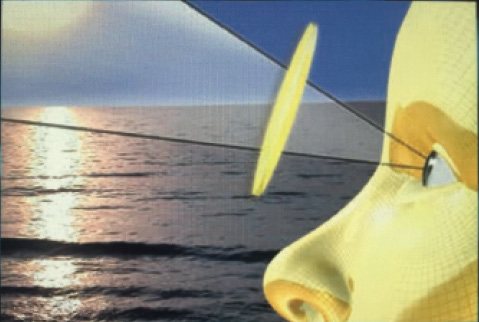
Until recently, all IOLs on the market had either been transparent and contained a UV-blocking filter or yellow and had the additional ability to filter blue light. The choice of which type of IOL to use is often a problem for the surgeon, as he or she wants to protect the patient’s macula from harmful blue light but also give the patient the best possible quality of vision without impairing his or her circadian rhythms.
Now a new aspheric IOL, one incorporating a pigment with photochromic properties, is able to combine retinal protection from harmful blue light with excellent quality of vision in all light conditions. The Focus Acrylic éclipse lens (eyePx; distributed by Ophta France) is a one-piece hydrophobic acrylic IOL that can be inserted through a 2.4-mm incision. The pigment molecules of the lens are made of two substructures connected by a spiro-carbon bond (Figure 1). Upon exposure to UV light, the spiro-carbon bond breaks, and this is followed by the appearance of a large co-planar molecule that absorbs a portion of the blue-colored rays. As a result, the lens turns yellow as it is activated, with an absorption curve comparable to that of a 53-year-old human crystalline lens (Figure 2).1

Figure 1. The pigment molecules in the éclipse IOL are made up of two substructures connected by a spiro-carbon bond.

Figure 2. Upon exposure to UV light, the spiro-carbon bond breaks, and the lens is activated and turns yellow.
THE EFFECTS OF BLUE LIGHT
Studies have shown the harmful effects of blue light on the retina and choroid. Exposure to blue light is known to increase oxidative stress, and the European Eye Study showed a clinical correlation between cumulative environmental blue light exposure and neovascular age-related macular degeneration (AMD) in patients with low levels of antioxidants in the blood.2 While it filters out harmful blue light, the éclipse IOL allows sufficient blue light to penetrate the eye in order to prevent changes to patients’ circadian rhythms.
Just as the ear is responsible for more than its basic function of hearing—including governing our ability to maintain balance—the eye has functions that are more than purely visual. This understanding stems from the identification in 1998 of a retinal pigment called melanopsin, which is found in the photosensitive ganglion cells.3 These photoreceptor cells do not provide visual information; rather, they are involved in the regulation of circadian rhythms. Because melanopsin photoreceptors reach peak light absorption at the blue-light wavelengths, this function may therefore be less affected by a photochromic lens than by a traditional blue-light–blocking IOL.
Because of the photochromic effect of the éclipse IOL, it will not interfere with patients’ sleep patterns or circadian rhythms in the same way that a yellow, blue-light–filtering IOL may.
At a Glance
• The Focus Acrylic éclipse lens, incorporating a pigment with photochromic properties, is able to combine retinal protection from harmful blue light with excellent quality of vision in all light conditions.
• The absorption curve of the IOL, when activated, is comparable to that of a 53-year-old human crystalline lens.
CASE EXAMPLES
I have had excellent clinical results with the éclipse IOL, and my experience is illustrated by the two patient examples described below.
Case No. 1. A 75-year-old woman who had bilateral drusen and was living in a poorly lit retirement home presented for cataract surgery. I chose to implant an éclipse IOL with the aim of protecting the macula from intense blue light that can occur on sunny days, but still allowing sufficient blue light to reach the retina during poorly lit days in order to maintain her normal circadian rhythms.
Postoperative results were good, with bilateral UCVA of 0.0 logMAR. On the Farnsworth-Munsell 100 hue test, her blue color vision was normal under photopic and mesopic conditions, and there has been no need for Nd:YAG capsulotomy after 3 years of follow-up.4
Case No. 2. A 50-year-old man who was an airplane pilot presented with bilateral cataracts and normal retinas. My goals were to protect the patient’s maculas from the intensive blue light exposure present in an airplane cockpit during daytime flights and also to maintain perfect color vision during night flights so that he could read the instruments in the safest possible way. The éclipse IOL was chosen because it is the only IOL, as far as I know, that can address both of those goals.
In this case, too, postoperative results were good, with bilateral visual acuity of -0.1 logMAR, normal blue color vision under both mesopic and photopic conditions, and no need for Nd:YAG capsulotomy after 4 years of follow-up.4
In consideration of the excellent results we have had with the éclipse IOL, it has now become my IOL of choice for the majority of my cataract patients. n
1. Werner L, Mamalis N, Romaniv N, et al. New photochromic foldable intraocular lens: preliminary study of feasibility and biocompatibility. J Cataract Refract Surg. 2006;32(7):1214-1221.
2. Augood CA, Vingerling JR, de Jong PT, et al. Prevalence of age-related maculopathy in older Europeans: the European Eye Study (EUREYE). Arch Ophthalmol. 2006;124(4):529-535.
3. Provencio I, Jiang G, De Grip WJ, Hayes WP, Rollag MD. Melanopsin: An opsin in melanophores, brain, and eye. Proc Natl Acad Sci U S A. 1998;95(1):340-345.
4. Ferrari F. Étude comparative multicentrique sur 91 patients portant sur la vision des couleurs, entre l’implant photochromique «Éclipse» et l’implant Alcon SN60WF. Paper presented at: Congrès SAFIR; May 10-11, 2014; Paris.
Francis Ferrari, MD
• Private practice, Futura Eye Clinic, Schiltigheim, France
• francisferrari@icloud.com
• Financial disclosure: None
